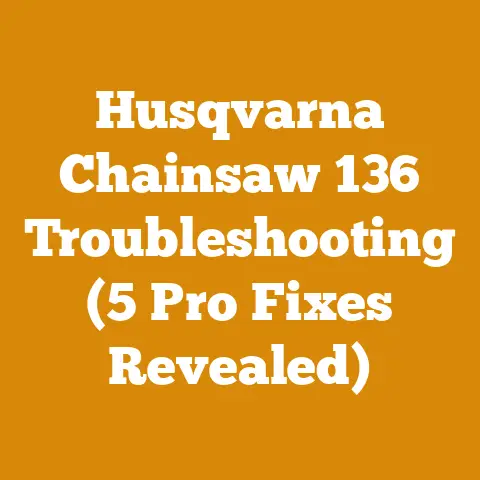How Do You Measure the Length of a Chainsaw Bar? (Pro Tips)
Alright, let’s get down to brass tacks. You want to know how to measure a chainsaw bar, and you want the straight dope, pro tips included. You’ve come to the right place. I’ve spent years felling trees, bucking logs, and prepping firewood, and knowing your bar length is absolutely critical for safety, efficiency, and getting the right replacement parts. It’s not just about slapping a ruler on it; there’s a right way and a wrong way. So, put on your safety glasses (metaphorically, for now), and let’s dive in.
Why Measuring Your Chainsaw Bar Matters: More Than Just Bragging Rights
Before I get into the nitty-gritty of how, let’s talk about why this is so important. A lot of folks think it’s just about showing off the biggest saw at the lumberyard. But it’s far more practical than that.
- Safety: Using the wrong bar length for your chainsaw can be downright dangerous. Too long, and you risk losing control, especially if you’re not experienced. Too short, and you’re limiting your cutting capacity and potentially overworking the saw.
- Performance: Matching the bar length to the engine size is crucial for optimal performance. A small engine struggling to drive a long bar will bog down and wear out quickly. Conversely, a large engine with a tiny bar is just inefficient.
- Replacement Parts: When it comes time to replace your chain, bar, or even the sprocket, knowing the exact bar length is essential for ordering the correct parts. Trust me, you don’t want to be stuck in the woods with the wrong chain.
- Matching the Job: Different jobs require different bar lengths. Felling large trees demands a longer bar, while pruning smaller branches calls for something more maneuverable.
- Understanding Your Saw’s Capabilities: Knowing the maximum recommended bar length for your chainsaw model is critical. Exceeding it can damage the saw and void the warranty.
Personal Anecdote: I remember one time, early in my firewood business, I tried to push the limits and put a longer bar on my Stihl MS 290 than it was designed for. I thought I was being clever, maximizing my cutting capacity. What happened? The engine constantly bogged down, the chain kept throwing, and eventually, I burned out the clutch. It was a costly lesson in respecting the manufacturer’s recommendations.
Defining Key Terms: Chainsaw Lingo 101
Let’s make sure we’re all speaking the same language. Here’s a quick glossary of terms you’ll need to know:
- Chainsaw Bar (Guide Bar): The metal blade that guides the chain. It’s the part you measure.
- Cutting Length (Usable Length): The actual length of the bar that’s available for cutting. This is the measurement we’re after.
- Overall Length: The total length of the bar, including the mounting tang (the part that attaches to the saw). This is not what we measure for replacement purposes.
- Pitch: The distance between any three consecutive rivets on the chain, divided by two. This determines the chain size.
- Gauge: The thickness of the drive links (the part of the chain that sits in the bar groove). This determines the bar groove width.
- Drive Links: The teeth on the chain that engage with the sprocket. The number of drive links is crucial for chain replacement.
- Sprocket: The toothed wheel that drives the chain.
- Green Wood: Freshly cut wood with a high moisture content.
- Seasoned Wood: Wood that has been dried to reduce its moisture content, making it easier to burn.
Step-by-Step Guide: Measuring Your Chainsaw Bar the Right Way
Okay, let’s get to the meat of it. Here’s a step-by-step guide to measuring your chainsaw bar accurately:
Step 1: Safety First!
- Turn off the chainsaw and disconnect the spark plug wire. This is absolutely crucial to prevent accidental starting.
- Wear gloves. Chainsaw bars can have sharp edges, even when the chain is removed.
- Place the chainsaw on a stable surface. A workbench or sturdy table is ideal.
Step 2: Remove the Chain
- Loosen the bar nuts that hold the bar cover in place.
- Remove the bar cover.
- Carefully remove the chain from the bar.
Step 3: Identify the Cutting Length (Usable Length)
This is the most important step. The cutting length is the length of the bar that’s actually used for cutting. It’s not the total length of the bar.
- Locate the bar mount. This is the part of the bar that fits into the chainsaw.
- Measure from the tip of the bar to the point where the bar enters the chainsaw housing. This is your cutting length.
- Use a flexible measuring tape or a ruler. A flexible tape measure is ideal for following the curve of the bar.
- Measure in inches or centimeters. Most chainsaw bars are measured in inches, but centimeters are perfectly acceptable if that’s your preference.
Step 4: Double-Check Your Measurement
- Measure at least twice to ensure accuracy. It’s easy to make a mistake, so double-checking is always a good idea.
- Round to the nearest inch or half-inch. Chainsaw bars typically come in standard lengths, so rounding is acceptable. For example, if you measure 17.5 inches, round up to 18 inches. If you measure 17.25 inches, round down to 17 inches.
Step 5: Record Your Measurement
- Write down the measurement in a safe place. You’ll need it when you’re ordering replacement parts or selecting a new chainsaw.
- Consider taking a photo of the measurement with your phone. This can be helpful for future reference.
Important Note: Never measure the entire length of the bar, including the mounting tang. This will give you an inaccurate measurement. You only want the cutting length.
Pro Tips for Accurate Measurement
Here are a few pro tips I’ve learned over the years to ensure you get the most accurate measurement possible:
- Use a New Measuring Tape: Old measuring tapes can stretch or become inaccurate over time. A new, high-quality tape measure will give you the most accurate results.
- Measure on a Flat Surface: Place the bar on a flat surface to ensure it’s not bent or warped. A warped bar can throw off your measurement.
- Clean the Bar First: Dirt and debris can obscure the markings on the bar and make it difficult to get an accurate measurement. Wipe down the bar with a clean cloth before measuring.
- Check the Manufacturer’s Markings: Many chainsaw bars have the length stamped directly on them. Look for these markings before you start measuring. However, always double-check the stamped measurement with your own measurement to be sure. Over time, the stamped markings can wear off or become difficult to read.
- Consult Your Chainsaw’s Manual: The owner’s manual for your chainsaw will list the recommended bar lengths for your model. This is a great way to confirm your measurement and ensure you’re using the correct bar.
Case Study: The Importance of Accurate Measurement in a Timber Harvesting Operation
Let me tell you about a time when inaccurate bar measurements almost cost my timber harvesting crew a whole day of work. We were contracted to fell a stand of mature oak trees for a local lumber mill. We had three experienced chainsaw operators, each with their own saws.
One of the operators, let’s call him Bob, needed a new chain for his Stihl MS 462. He thought he remembered the bar length, ordered a new chain online, and showed up on site ready to go. However, when he tried to install the new chain, it was too short.
We wasted almost two hours trying to figure out what went wrong. Bob insisted he had ordered the right chain, but it just wouldn’t fit. Finally, I grabbed my own measuring tape and measured Bob’s bar. Turns out, he had ordered a 20-inch chain for a 24-inch bar.
The mistake cost us valuable time and productivity. We had to send someone back to town to buy the correct chain, delaying the entire operation. It was a stark reminder of the importance of accurate bar measurements. From that day on, we made it a policy to always double-check bar lengths before ordering replacement parts.
Understanding Chainsaw Bar Length and Engine Size: A Perfect Match
The length of your chainsaw bar should be proportional to the engine size of your saw. Using a bar that’s too long for the engine will put unnecessary strain on the motor and reduce its cutting efficiency. Conversely, using a bar that’s too short will limit your cutting capacity.
Here’s a general guideline for matching bar length to engine size:
- Small Chainsaws (30-40 cc): 12-16 inch bar
- Medium Chainsaws (40-50 cc): 16-20 inch bar
- Large Chainsaws (50-60 cc): 20-24 inch bar
- Professional Chainsaws (60+ cc): 24-36+ inch bar
These are just general guidelines, and the specific recommendations may vary depending on the chainsaw manufacturer and model. Always consult your owner’s manual for the recommended bar lengths for your saw.
Example: My Stihl MS 271 has a 50cc engine. The manual recommends a bar length of 16-20 inches. I typically use an 18-inch bar for most of my firewood cutting needs.
Chainsaw Bar Types: Matching the Bar to the Job
Not all chainsaw bars are created equal. Different types of bars are designed for different applications. Here are a few common types of chainsaw bars:
- Solid Bars: These are the most common type of bar and are typically made from a single piece of steel. They are durable and versatile, suitable for a wide range of cutting tasks.
- Laminated Bars: These bars are made from multiple layers of steel that are bonded together. They are lighter than solid bars and are often used on smaller chainsaws.
- Sprocket Nose Bars: These bars have a sprocket at the tip that helps to reduce friction and improve cutting speed. They are often used for felling large trees.
- Carving Bars: These bars are designed for carving wood and have a narrow tip that allows for intricate cuts.
The type of bar you choose will depend on the type of cutting you’ll be doing. For general firewood cutting and tree felling, a solid bar is usually the best choice. For carving, a carving bar is essential.
Chainsaw Chain Selection: Pitch, Gauge, and Drive Links
Choosing the right chainsaw chain is just as important as choosing the right bar. The chain must match the bar in terms of pitch, gauge, and number of drive links.
- Pitch: The pitch is the distance between any three consecutive rivets on the chain, divided by two. Common pitches include 3/8″, .325″, and .404″.
- Gauge: The gauge is the thickness of the drive links (the part of the chain that sits in the bar groove). Common gauges include .050″, .058″, and .063″.
- Drive Links: The number of drive links is the number of teeth on the chain that engage with the sprocket.
To determine the correct chain for your chainsaw, you’ll need to know the pitch, gauge, and number of drive links. This information is usually stamped on the bar or listed in the owner’s manual.
Example: My Stihl MS 271 uses a 3/8″ pitch chain with a .050″ gauge. The chain I use has 62 drive links.
Chainsaw Maintenance: Keeping Your Bar and Chain in Top Condition
Proper maintenance is essential for extending the life of your chainsaw bar and chain. Here are a few tips:
Here are a few common pitfalls to avoid:
- Measuring the overall length instead of the cutting length. This is the most common mistake.
- Using the wrong bar length for the engine size. This can damage the engine and reduce cutting efficiency.
- Using the wrong chain for the bar. The chain must match the bar in terms of pitch, gauge, and number of drive links.
- Not maintaining the bar and chain properly. This can lead to premature wear and failure.
- Ignoring safety precautions. Always wear appropriate safety gear and follow the manufacturer’s instructions.
Beyond Measurement: Chainsaw Safety and Best Practices
Measuring your chainsaw bar is just one piece of the puzzle. Safety is paramount when operating a chainsaw. Always wear appropriate safety gear, including:
- Eye protection: Safety glasses or a face shield are essential to protect your eyes from flying debris.
- Hearing protection: Chainsaws are loud and can cause hearing damage over time. Wear earplugs or earmuffs.
- Head protection: A hard hat will protect your head from falling branches and other hazards.
- Hand protection: Gloves will protect your hands from cuts and abrasions.
- Leg protection: Chainsaw chaps or pants will protect your legs from accidental cuts.
- Foot protection: Steel-toed boots will protect your feet from falling logs and other hazards.
In addition to wearing safety gear, it’s important to follow these best practices:
- Read the owner’s manual carefully. Understand the operation and maintenance of your chainsaw.
- Inspect the chainsaw before each use. Check for any loose parts or damage.
- Start the chainsaw on a stable surface. Make sure the chain is not touching anything.
- Use a firm grip with both hands. Keep your thumbs wrapped around the handles.
- Maintain a safe distance from others. Keep bystanders at least twice the length of the bar away from the cutting area.
- Be aware of your surroundings. Watch out for overhead hazards, such as branches and power lines.
- Don’t cut above your head. This is dangerous and can lead to loss of control.
- Take breaks regularly. Chainsaw operation can be physically demanding.
- Never use a chainsaw when you’re tired or under the influence of drugs or alcohol.
Firewood Preparation: From Log to Stack
Now that you know how to measure your chainsaw bar and operate your saw safely, let’s talk about firewood preparation. Here’s a basic overview of the process:
- Felling the Tree: Choose a tree that’s suitable for firewood and fell it safely.
- Bucking the Logs: Cut the felled tree into manageable lengths. This is where your chainsaw bar length comes into play. A longer bar allows you to buck larger logs.
- Splitting the Wood: Split the logs into smaller pieces that are easier to handle and burn.
- Stacking the Firewood: Stack the firewood in a way that allows for good air circulation.
- Seasoning the Firewood: Allow the firewood to dry for at least six months, preferably longer. Seasoned firewood burns hotter and cleaner than green wood.
Tools for Firewood Preparation:
- Chainsaw: For felling and bucking.
- Axe or Maul: For splitting wood manually.
- Log Splitter: A hydraulic or electric machine for splitting wood. This significantly increases efficiency, especially for large volumes of wood.
- Measuring Tape: For measuring log lengths.
- Wedges: For splitting particularly tough logs.
- Sledgehammer: For driving wedges.
- Wheelbarrow or Cart: For moving firewood.
- Gloves: For protecting your hands.
- Safety Glasses: For protecting your eyes.
Wood Types for Firewood:
- Hardwoods: Oak, maple, ash, birch, and hickory are all excellent choices for firewood. They burn hot and long.
- Softwoods: Pine, fir, and spruce can also be used for firewood, but they burn faster and produce more smoke.
Seasoning Firewood:
Seasoning firewood is crucial for efficient burning. Green wood contains a high moisture content, which makes it difficult to ignite and produces a lot of smoke. Seasoned wood, on the other hand, burns hotter and cleaner.
To season firewood, stack it in a single row, off the ground, in a sunny and windy location. Allow it to dry for at least six months, preferably longer. The ideal moisture content for firewood is below 20%. You can use a moisture meter to check the moisture content of your firewood.






